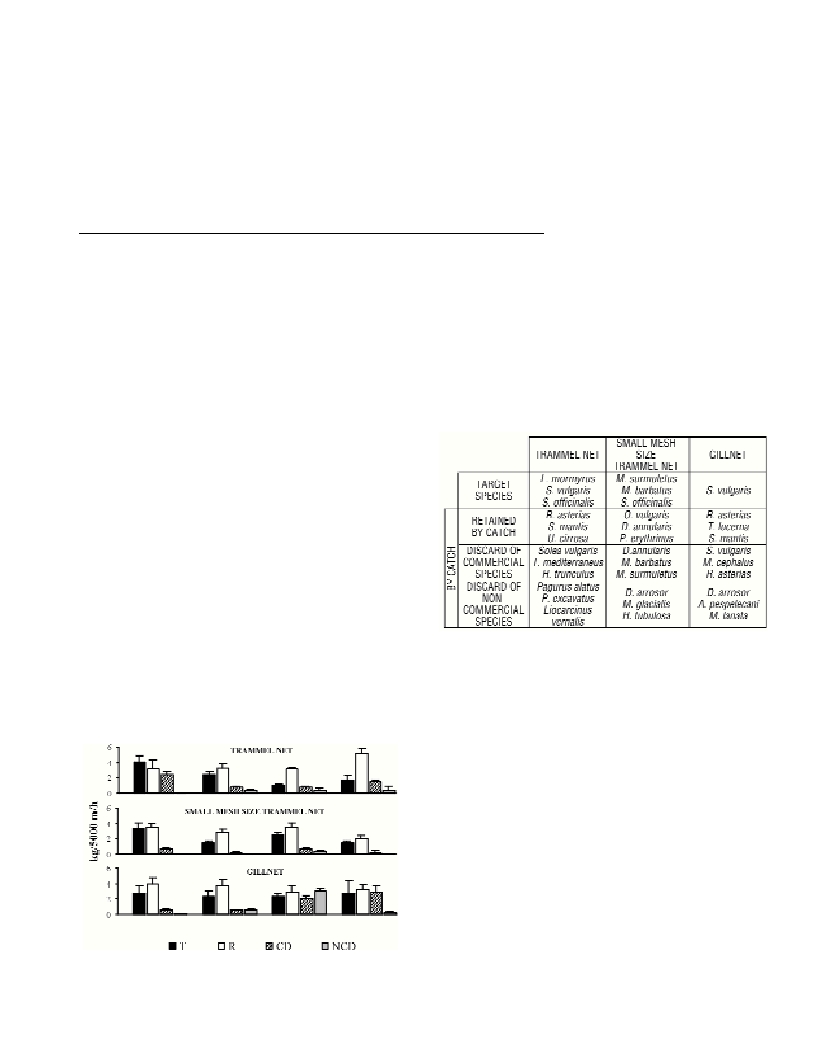CATCH COMPOSITION OF SET NETS USED BY THE SMALL-SCALE FISHERY OF LIVORNO
(EASTERN LIGURIAN SEA)
M. Sbrana
1
, B. Francesconi
2
, I. Rossetti
2*
, P. Sartor
1
, S. De Ranieri
1
1
Centro Interuniversitario di Biologia Marina ed Ecologia Applicata, Livorno, Italy
2
Cooperativa di ricerca Aplysia, Livorno, Italy - aplysia1@libero.it
Abstract
Catch composition of three types of set nets used by the small-scale fishery of Livorno (eastern Ligurian Sea) was studied by observations
on board of commercial vessels, from January 1999 to December 2000. Standard trammel nets, small mesh size trammel nets and gillnets
were studied. Target species and retained by-catch represented the majority of the biomass caught with the two types of trammel nets all
year round. Discarding was noticeable for gillnet only in summer and autumn.
Key-words: artisanal fishery, set nets, catch composition, coastal management, Ligurian Sea
Rapp. Comm. int. Mer Médit., 37,2004
436
Introduction
The small-scale fishery is an important sector of the Livorno ?eet;
this activity is carried out with different types of set nets, used in sea-
sonal succession according to the main target species and the avail-
ability of resources (1, 2). This paper describes the catch composition
of these gears, paying particular attention to discards, an important
information for an ecological-based management (3). This work was
performed whithin a project funded by the Italian Ministero delle
Politiche Agricole e Forestali (2).
Material and methods
From January 1999 to December 2000, 49 observations onboard of
commercial vessels of the artisanal ?eet of Livorno were carried out,
considering three types of set nets: standard trammel nets (60-70 mm
stretched mesh size of inner panel), trammel nets of smaller mesh
sizes (40-45 mm, stretched), locally called “tramaglino”, and gillnets
(80-85 mm, stretched). The composition of the catch, discards includ-
ed, was studied without interference in the usual fishing procedures of
the crew, especially concerning the sorting operations. For each haul
the catch was divided in: target species, retained by-catch, discard of
commercial and non-commercial species (3). Discard was determined
to the lowest taxonomic level; total weight was recorded for each
species caught. Catch per unit of effort (cpue) was estimated, standar-
dising the collected data as kg/5000 m of net per hour of hauling.
Results and discussion
A total of 95 species were caught with trammel nets (59 fishes, 13
molluscs, 19 crustaceans and 4 echinoderms), 111 with “tramaglino”
(69 fishes, 10 molluscs, 21 crustaceans, 1 cnidarian and 10 echino-
derms) and 68 with gillnets (45 fishes, 11 molluscs, 10 crustaceans
and 2 echinoderms).
In terms of weight, the majority of the total catch was composed of
commercial species (target species + retained by catch), especially for
trammel nets (69 to 84%) and “tramaglino” (91 to 94%), while this
percentage was lower for gillnets (51 to 92%). For the latter, notice-
able amounts of discards were recorded in summer and autumn (5.0
and 3.1 kg/5000m/h, representing 49 and 34% of the total catch,
respectively) (Fig. 1).
Table 1 shows the main species per catch category and gear stud-
ied. The target species of trammel nets (Sepia officinalis, Solea vul-
garisand Lithognathus mormyrus)accounted for 19-42% of the total
catch, those of “tramaglino” (Mullus barbatus, Mullus surmuletusand
S. officinalis) from 35 to 45% and that of gillnets (S. vulgaris) from
22 to 37%. Retained by-catch also had an important contribution, with
generally higher cpues than those for the target species (from 2.1 to
5.2 kg/5000m/h compared to 1.5-4.0 kg/5000m/h of the target species,
Fig. 1). Important species of this fraction, both in terms of weight and
commercial value, were Raja asterias,Umbrina cirrosa, Pagellus ery-
thrinus, Octopus vulgaris and Squilla mantis.
Discards, in terms of weight, were mostly composed of commercial
species (77 to 97% of total discards) and dominated by fishes, often
represented by damaged and unmarketable specimens. Non-commer-
cial species discarded were mostly represented by small-sized species,
re?ecting the composition of the epibenthic communities inhabiting
the exploited fishing grounds.
References
1-Sbrana M., Reale B., Rossetti I., and Sartor P., 2002. Fishing grounds
of the target species exploited by the artisanal ?eet of Livorno (eastern
Ligurian sea). Biol. Mar. Medit., 9(2): 804-807.
2-Fabi G., and Sbrana M., 2002. Attrezzi della piccola pesca utilizzati in
funzione della successione stagionale e dell’eco-etologia delle specie
ittiche in due aree costiere (Tirreno settentrionale e Medio Adriatico).
Ministero delle Politiche Agricole e Forestali, Final report, 159 p.
3-Alverson D.L., Freeberg M.H., Pope J.G., and Murawski S.A., 1994. A
global assessment of fisheries bycatch and discards. FAOFish. Tech. Pap.,
339, 233 p.
Fig. 1. Seasonal catches per unit of effort (mean cpue + standard error)
of set nets used by the artisanal ?eet of Livorno. T = Target species; R =
Retained by catch; CD = Discard of commercial species; NCD = Discard of
non-commercial species.
Table 1. The most important species in biomass of the different fractions
of the catch, by gear.

